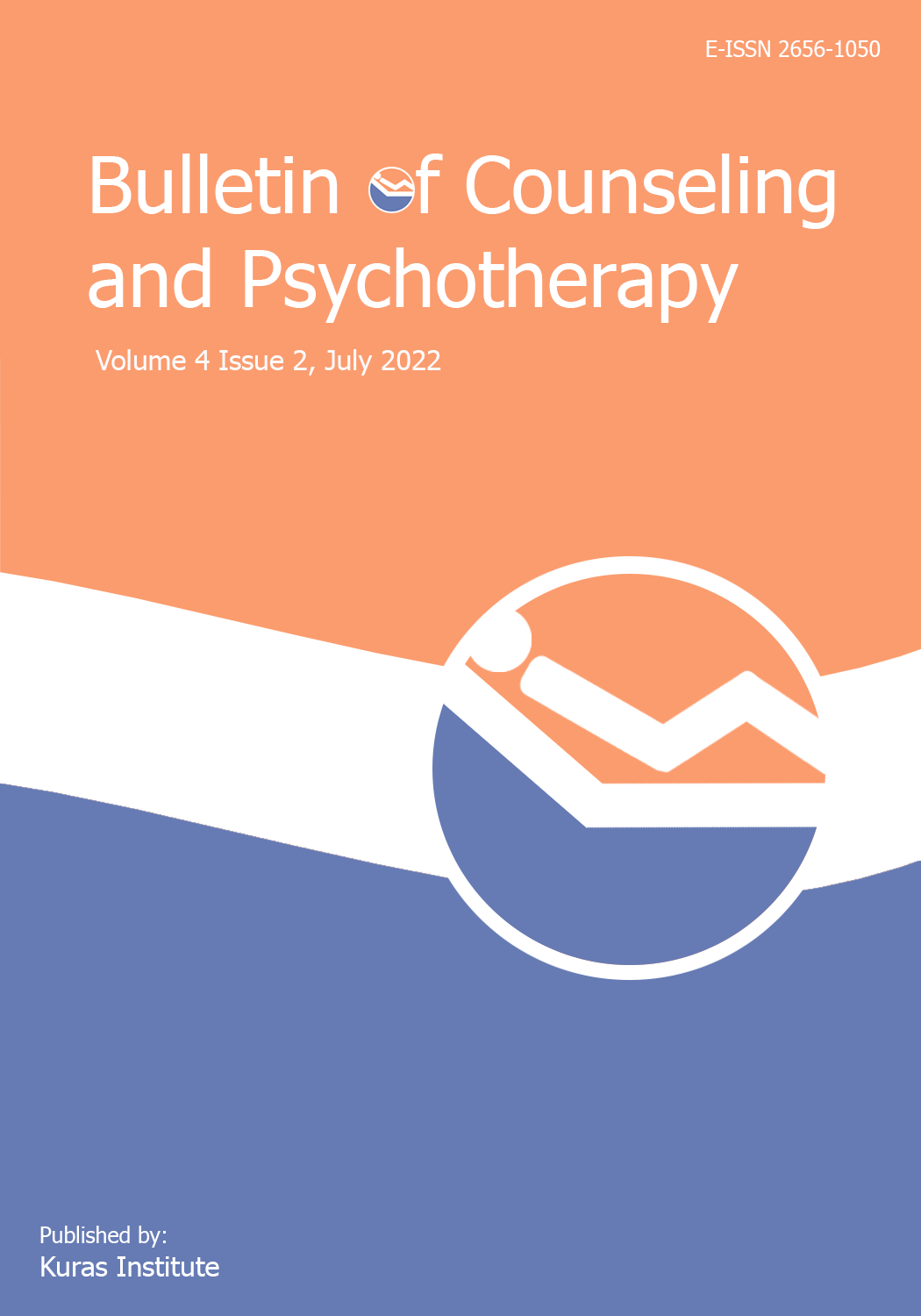Family Therapy dalam Gangguan Emosi dan Kenakalan Remaja Pada Anak dari Lingkungan Lahan Rawa
Abstract
This study aims to determine family therapy in emotional disorders and juvenile delinquency. This study covers emotional disorders and juvenile delinquency that occur to students. The results of observations and preliminary studies conducted by researchers at MTsN 1 Banjarmasin juvenile delinquency can arise because there is no acceptance, warmth, protection, uncontrolled anxiety development, depressed mood, and psychological stress. This study uses a quantitative approach with experimental methods. In this study, the experimental design used was "Randomized Pretest-Posttest Comparison Group". The results of the validity test of the Self Reported Delinquency Scale (SRSD) instrument were declared valid on all items with (rxy = 0.510 – 0.860) and an alpha coefficient of 0.751. Meanwhile, the results of the validity test of the Scale for Assessing Emotional Disturbance (SAED) instrument were also declared valid on all items with (rxy = 0.534 – 0.764) and an alpha coefficient of 0.753. The data obtained were then analyzed using the Wilcoxon test, Kruskal Wallis test and gain test. Based on the results of the data analysis above, it can be understood that group counseling services with family therapy are effective in reducing the level of emotional disturbance and juvenile delinquency in MTsN 1 Banjarmasin students. From the results of this study, it is known that family therapy group counseling is proven to be effective in reducing juvenile delinquency and emotional disorders in students of MTsN 1 Banjarmasin. Both experimental groups showed a decreased score after being given treatment, namely family therapy group counseling services.
Downloads
References
Almasitoh, U. H. (2012). Model terapi dalam keluarga. Jurnal Magistra No. 80, ISSN 0215, 9511. Google Scholar
Cresswell, John W. (2015). Penelitian Kualitatif & Desain Riset. Yogyakarta: Pustaka Pelajar. Google Scholar
Fatma, S.H. (2019). Bowenian Family Therapy Untuk Meningkatkan Self differentiation Pada Keluarga Dengan Kasus Poligami. Jurnal Psikologi Islam. 6 (2): 51-62. Google Scholar
Ferdinand , R. F., & Verhulst, F. C. (1996). The prevalence of self-reported problems in young adults from the general population. Social Psychiatry and Psychiatric Epidemiology, 31, 10-20. https://doi.org/10.1007/BF00789117
Goldenberg, I. (2008). Family therapy (an oerview, seventh edition). USA: Thomson Brooks/Cole. Google Scholar
Haefner, Judy. (2014). An Application of Bowen Family Systems Theory. Issues in Mental Health Nursing, 35:835–841. https://doi.org/10.3109/01612840.2014.921257
Hagan, B. S., Kwok, O. M., Zou, Y., Johnson, C., Simmons, D., & Coyne, M. D. (2011). An examination of problem behaviors and reading outcomes in kindergarten students. The Journal of Special Education,, Vol. 45, 131-148. https://doi.org/10.1177%2F0022466909359425
Hasnida. (2002). Family Counseling. Program Studi Psikologi. Tesis. USU digital library. Google Scholar
Karlina, Lilis. (2020). Fenomena Terjadinya Kenakalan Remaja. Jurnal Edukasi Nonformal. E-ISSN: 2715-2634. Google Scholar
McKenna, J. W., Adamson, R., & Solis, M. (2019). Reading Instruction for Students with Emotional Disturbance: A Mixed- Methods Investigation. Behavior Modification Article, 1-39. https://doi.org/10.1177%2F0145445519868804
McKenna, J., Shin, M., Solis, M., Mize , M., & Pfannenstiel, K. (2019). Effects of single-case reading interventions for students with and at-risk of emotional and behavioral disorders in grades K-12: A quantitative synthesis. Psychology in the Schools,, 56(4), 608-629. https://doi.org/10.1002/pits.22242
Mubasyiroh, R., Putri, I. Y., & Tjandrarini, D. H. (2017, Juni). Mental Emotional Symptoms Determinants Of Junior-Senior High School Student In Indonesia 2015. Buletin Penelitian Kesehatan, Vol. 45, No. 02, PP: 103-112. Google Scholar
Overbeek, G., Vollebergh, W., Engels, R., & Meeus, W. (2005). Juvenile delinquency as acting out: Emotional disturbance mediating the effects of parental attachment and life events. European Journal Of Developmental Psychology, 2 (1), 39-46. https://doi.org/10.1080/17405620444000184
Sumara. D, Humaedi. S, Santoso. M.B. (2017). Kenakalan Remaja Dan Penanganannya. Jurnal Penelitian & PPM. 4 (2), 129-389. https://doi.org/10.24198/jppm.v4i2.14393
Tolan, P. H., & Lorion, R. P. (1988). Multivariate approaches to the identification of delinquency proneness in adolescent males. American Journal of Community Psychology, 16(4), 547–561. https://doi.org/10.1007/BF00922770
Trout, A., Nordness, P., Pierce, C., & Epstein, M. (2003). Research on the academic status of children and youth with emotional and behavioral disorders: A review of the literature from 1961 to 2000. Journal of Emotional and Behavioral Disorders, 11, 198-210. https://doi.org/10.1177%2F10634266030110040201
Utami, Wahyu. (2017). Strategic Family Therapy Untuk Memperbaiki Komunikasi Dalam Keluarga Di Nganjuk. Journal An-nafs: 2 (2). https://doi.org/10.33367/psi.v2i2.426
Videbeck, Sheila L. (2008). Buku Ajar Keperawatan Jiwa. Jakarta: EGC. Google Scholar
Wei, X., Blackorby, J., & Schiller, E. (2011). Growth in reading achievement of students with disabilities, ages 7 to 17. Exceptional Children. Vol. 78, 89-106. https://doi.org/10.1177%2F001440291107800106
Wery, J., & Cullinan, D. (2012). State Definitions of Emotional Disturbance. Journal of Emotional and Behavioral Disorders, XX(X) 1– 8. https://doi.org/10.1177%2F1063426611418234
Copyright (c) 2022 Zainal Fauzi, Sri Ayatani Hayati

This work is licensed under a Creative Commons Attribution 4.0 International License.
Authors who publish with this journal agree to the following terms:
1) Authors retain copyright and grant the journal the right to first publication, with the work simultaneously licensed under the Creative Commons Attribution that allows the sharing of articles published with the acknowledgement of authorship and the initial publication in this magazine.
2) The authors are authorized to make additional contracts separately for distribution of the version of the work published in this journal (for example, publication in an institutional repository or as a chapter of the book), as long as there is recognition of authorship and initial publication in this journal.
3) Authors are authorized and encouraged to publish and distribute their work online (for example, in institutional repositories or on their personal pages) at any time before or during the editorial process, as it increases the impact and reference of the published work.







